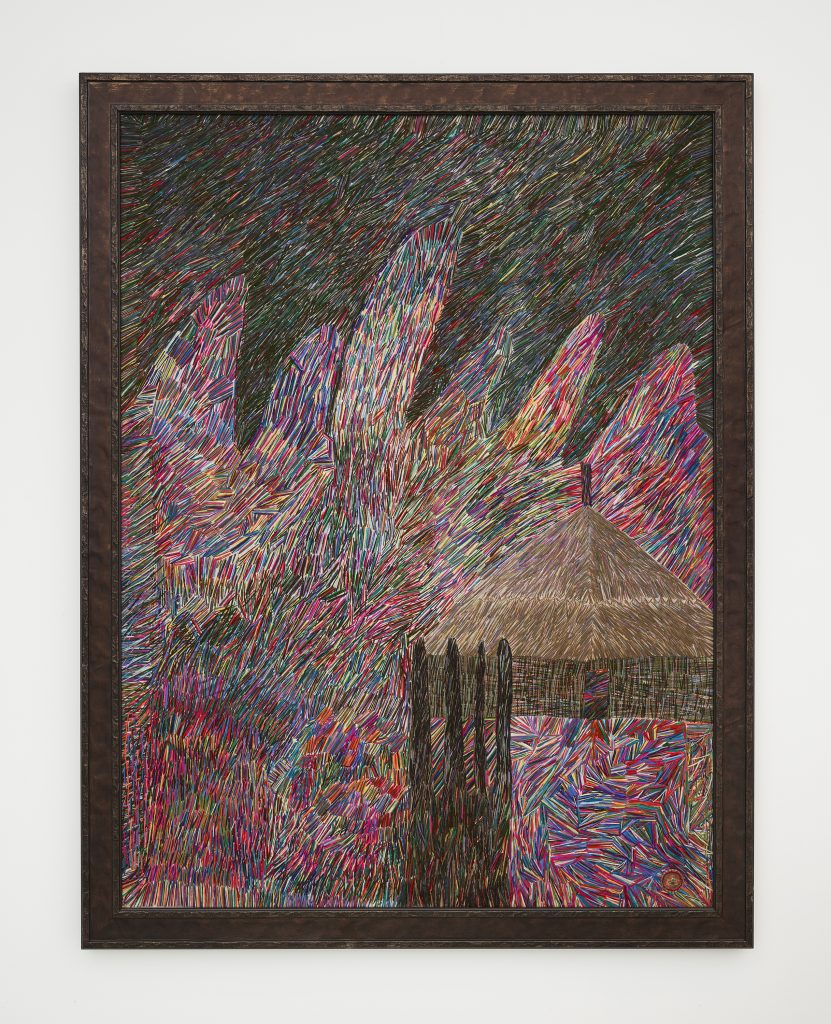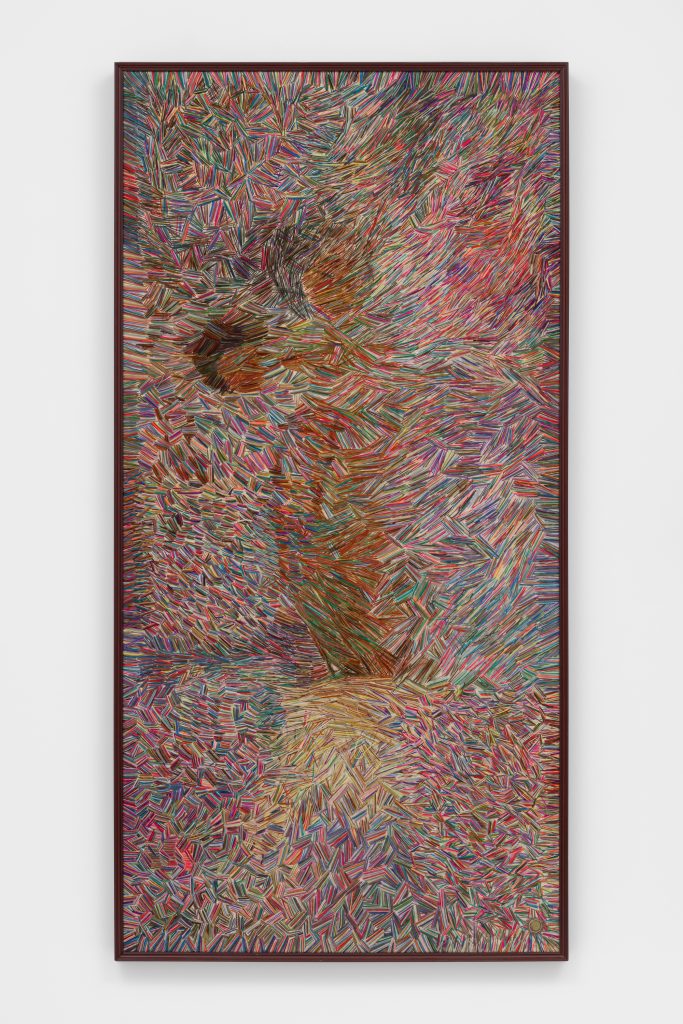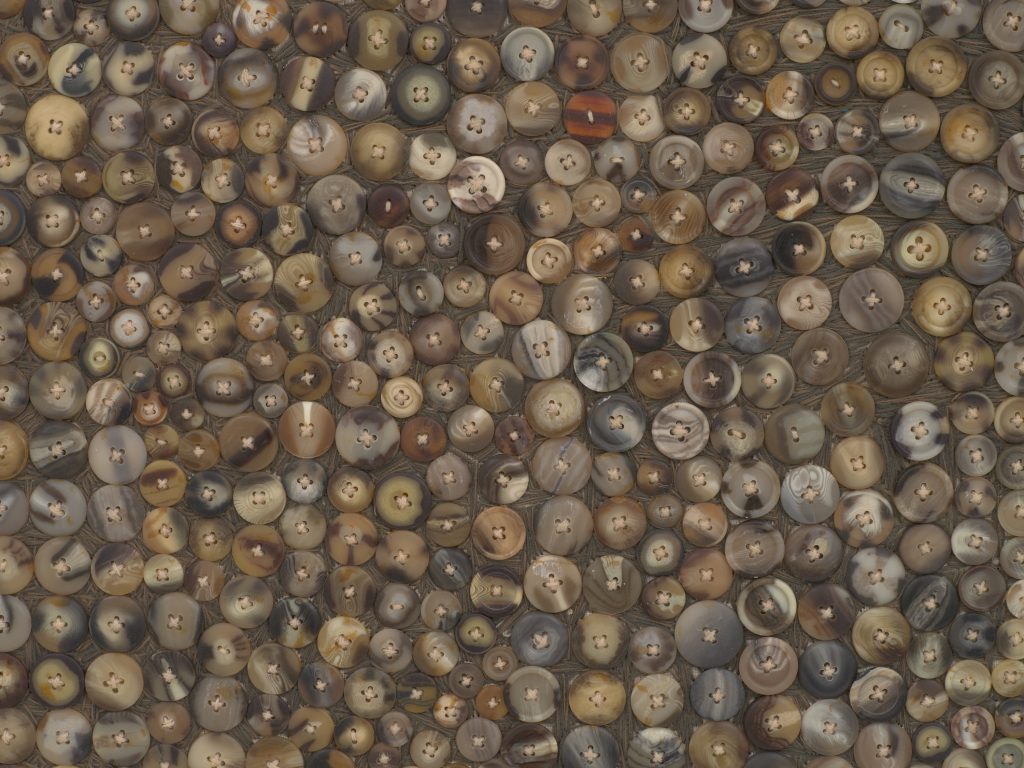I was instantly excited by the artworks of well-known artist Elias Sime included in a recently concluded exhibition at James Cohan gallery in New York City.
These pieces, which nodded to real-world environments of everyday, familiar, routine living, felt in terms of visual impact like they shimmered from within, infusing the progression from each moment and each point to the next with energy of not just possibility but progress, expansion, and reassurance.
Elias Sime at James Cohan
Sime’s artworks were wild with color while feeling quite welcoming. The imagery was caught in perpetual motion but in sync, moving as a perceptual environment with cohesion and focus: every point in space lifting into something moving, substantive, and satiating on an emotional level. It was an offering of resolution — a wave of color and artistic drive — at every point in time along the way.
These particular artworks’ materials included stitched yarn and found objects (particularly, buttons) on canvas, with some of the pieces just involving the stitched yarn. The yarn builds into images both recognizable from lived reality and not, like in “Untitled” from c. 2002, in which an apparent image of a place of residence sits against a backdrop of streaking, vibrant, and surging color.
The stitches in Sime’s artwork are generally big enough that each one comes into its own as a line, something beginning to move with visual character in addition to the physical nature of the artwork: image atop the process. Sime incorporated clusters of parallel stitches that bounced off each other and swept in their surroundings.
A methodical intimacy to Sime’s artistic constructions stuck out to me, as by nature he moved in the unique context of each of these pieces in repetition, gradually building up the entirety of what he was doing and leaving it so that the relational element that one stitch — one point on the artwork — had with the next was abundantly, forwardly evident. Sime’s artistically realized spaces were choruses of relationship buttressing the structures of perception.
Each juncture on Sime’s surfaces, cultivated into a flourish even in its vulnerability and precarity, felt enlivened and infused with the human ambition that would naturally lie behind these things (like buttons), made poignantly evident as possibility both promising and unsure. Sime allows for fragility, even as it remains in that state: the image and experience of a person or place looking like it could slip away into the thicket of color and texture.
Consistently, these moments in time and place that are spread across Sime’s artistic theaters of perception both coexist in heightened, internal fulfillment and communicate, leaving you with an apparent person, or a house, or a place, constructed in each instance from the assemblage and embedding of each underlying instance — each memory, feeling, or moment in time.
Sime’s art envisions interconnection between a person, their place, and that place’s place as a process moving moment by moment: ever-changing, ever-growing.

Each Point in Space, Enlivened
Experientially, any background in Sime’s works felt like simultaneously the foreground, as though he was activating an awareness of available facets to experience that might otherwise be taken for granted. The inward, wholly realized waves of energy constructed by the stitches of yarn feeding into these overarching images were consistent across his pieces. Separately from an encounter with any specific person, each place suggested in Sime’s art was itself offering emotively connecting resolve and connection, while sticking to a language of place: interweaving and perceptual layering in simultaneity, with the environment itself growing in its reach like a thicket of enrapturing, encircling vines.
Across the exhibition, it was the creation of perceived, lived space through linkage: the elevation of the pattern of progress itself, the seconds that move into hours and into longer periods, the smaller areas of the physically realized visual impression of a place that join to make it a whole. Process, progression, and a processional are front and center here.
And getting beyond what we already know is there, Sime also posits a psychological landscape, a realm of experience in which that progress really is the crux of it, a definition of presence by way of inwardly driven transformation.
Change as construction, the potential bursting out again and again: parallel possibilities living (in a literal sense, considering the nature of the stitching) alongside and above each other rather than one necessarily outdoing the other.
The cloud of potential always out there, always growing, another one added before you finish reading this sentence. Maybe I’d end it one way, or another.
In the art, I felt the melding of possibility alongside possibility into an experience of existence without necessarily the need for something overarching and conclusive: a religious, esoteric, heavenly, uplifting feeling from the smallest of moments, combined with nearby, perceptibly small moments and built into a construction that stands, that withstands, that persists, that offers a vantage point: an encompassing moment of connection alongside the individual ones leading up to that.
On display, I found the opportunity for something that feels far-reaching and enveloping in each skid: a constructive, transformative, instantly redone subsuming, not taking each moment up but finding the up in each moment, each spark. The interchange of point and point, place and place, and moment and moment, creating a constant, living process of creation, reassurance. A bridge.


Featured image: Elias Sime, “Enat, Teret-Teret,” 2004 (detail). Stitched yarn and buttons on canvas, 33 x 27 3/8 in., 83.8 x 69.5 cm. © Elias Sime 2024. Courtesy the artist and James Cohan, New York. Photo by Dan Bradica.
You may also like
-
Diana Kurz at Lincoln Glenn in New York: A Review of a Shining Art Exhibition
-
Dustin Hodges at 15 Orient in New York City: An Ensnaring Exhibition at an Exciting Gallery
-
Maren Hassinger at Susan Inglett Gallery in New York: Reviewing an Uplifting Art Exhibition
-
Enzo Shalom at Bortolami in New York City: Reviewing an Entrancing Exhibition of Paintings
-
“Ben Werther: Townworld” at Amanita in New York City: Reviewing a Richly Memorable Art Exhibition
